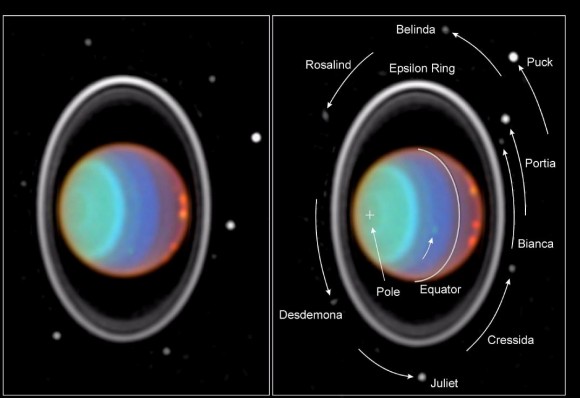Overview
The planet Uranus is the seventh planet from the Sun. It is about 3 billion km from the Sun, or about 20 times the distance from the Earth to the Sun. It is a giant planet composed mostly of ice. Its system of icy moons and dark rings is complex, and the planet is so far away that many of its features were unknown until the space probe Voyager 2 flew by it.
The Planet Uranus
Sir William Herschel observed Uranus through his telescope in 1781. It is very dim, and many scientists before him thought it was a comet, or maybe a faint star. At its distance, it takes over 84 years to complete one orbit around the Sun. However, a day takes only about 17 hours. Wind speeds can reach about 900 km/hr. The average temperature is about -224°C. It has three main layers, a rocky core, a dense fluid mantle made of water, ammonia, and methane, and similar compounds. The further away from the planet’s core, the more those compounds appear as conventional ices. Like the other giant planets, Uranus does not have a solid surface, but is made up of materials that flow under intense pressure. Its atmosphere is made up of hydrogen, helium, and methane, which makes the planet look blue.
Rings of Uranus
Uranus has at least 13 rings. They are relatively narrow, very dark, and probably made of ice contaminated with some sort of opaque particles. They are unlike the ring systems of Saturn and Jupiter, and may have been formed from the destruction of moons, as well as the gravitational capture of moonlets and outer satellites.
Moons of Uranus
Uranus has an extensive system of moons. The 13 inner moons are connected to the ring system, and also consist of ice and dark matter. Some of them have irregular orbits, and may collide with one another. The five largest moons are called Miranda, Ariel, Umbriel, Titania, and Oberon. They are made of ice and rock, and their surfaces show impact craters. The 9 moons that are the furthest away were probably captured by gravity shortly after the planet’s formation.
Exploration of Uranus
The Voyager 2 space probe was the first to fly by Uranus. Photographs were taken of the planet itself, its extensive ring system, and many of its moons. Recent discoveries have also been photographed from the Hubble Space Telescope. Future missions to Uranus include a joint mission between the United States and the United Kingdom, an orbiter that would launch in 2018 that would not reach Uranus until 2030, and solar-powered space probes that would use gigantic sails to navigate through space.
Interested in science tutoring services? Learn more about how we are assisting thousands of students each academic year.
SchoolTutoring Academy is the premier educational services company for K-12 and college students. We offer tutoring programs for students in K-12, AP classes, and college. To learn more about how we help parents and students in Swanzey, NH: visit Tutoring in Swanzey, NH




